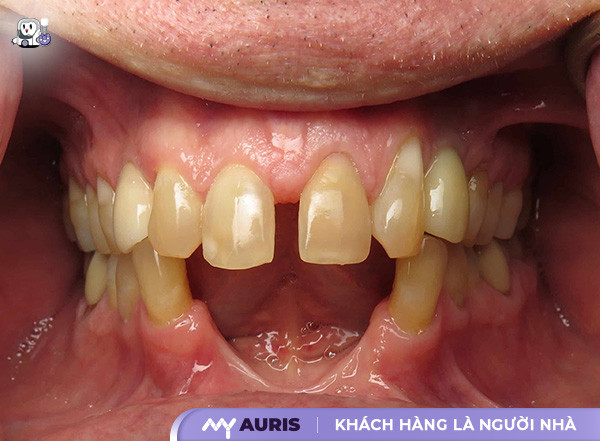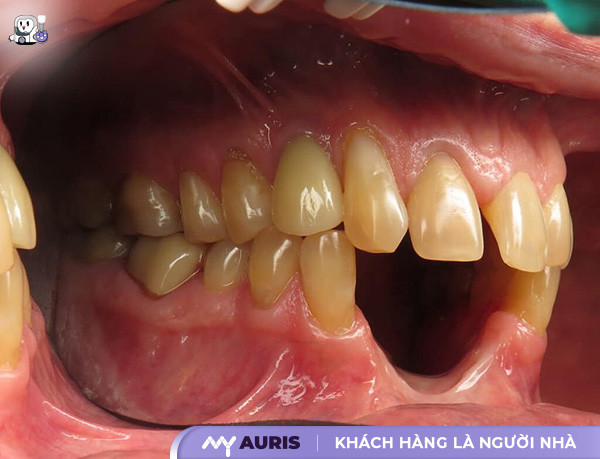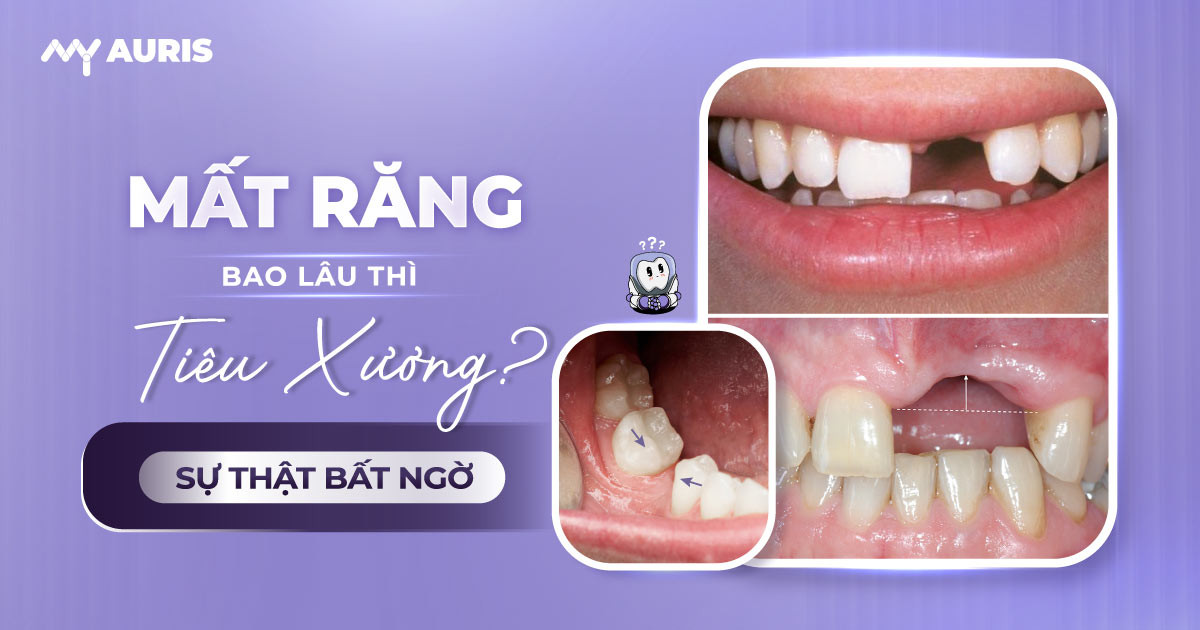Jaw bone loss occurs silently and slowly, making many people unaware until they have problems chewing or changing the shape of their face. Understanding jaw bone loss, types of bone loss, and prevention solutions is important to protect long-term oral health. My Auris will provide detailed information about the problem of jaw bone loss, helping you better understand this process and how to prevent it.
What is jaw bone loss?
Bone resorption jaw bone loss, also known as alveolar bone loss, is a phenomenon in which the bone supporting the teeth reduces in density and quality, often occurring in both the upper and lower jaw bones. When this process takes place, the gums tend to recede, creating a feeling of exposed tooth roots, leading to facial imbalance such as facial distortion, sagging, aging and seriously affecting the bite.
The loss of teeth causes the jawbone at that position to no longer bear the force of chewing, thereby stimulating bone destruction. Within the first 3 months after tooth loss, bone density begins to decline. On average, in 1 year, you can lose up to 25% of the bone at the site of the lost tooth. After 3 years, this number can increase to 45–60%, causing significant jaw bone deterioration.
Periodontitis is a long-term infection around the teeth, causing the gums to recede, tooth roots to be exposed, creating conditions for bacteria to attack the bones and ligaments around the teeth. Over time, these tooth support structures will be destroyed, causing the teeth to loosen, lose their attachment and fall out.

Types of jaw bone loss when tooth loss
After losing teeth due to age or accident, if teeth are not replaced promptly, the risk of jaw bone loss can occur quickly. This is a silent process but seriously affects the patient’s aesthetics, communication ability, and chewing function. Below are common forms of bone loss that need to be identified early:
Horizontal jaw bone loss
At this stage, the jawbone at the location of the lost tooth tends to narrow in direction. horizontal, reducing the width of the bone base. This imbalance causes the adjacent bone area to stretch and invade the bone resorption space, thereby leading to tooth misalignment, tilting, and loss of jaw regularity, directly affecting facial aesthetics and confidence when communicating.
Vertical jaw bone loss
The part of the jaw bone under the gum may be sunken, creating a significant difference compared to neighboring bone areas. The gum area at the bone loss site is also atrophied, affecting the foundation for future denture restorations, especially when implants are used.
Bone loss related to the maxillary sinus
In cases of tooth loss in the upper jaw, the maxillary sinus tends to overflow, thinning the bone base and making it more difficult to replace teeth with implants. If left for a long time, the enlarged maxillary sinus can affect the bone structure of the nose and cheeks.
Bone loss of the entire face
When many teeth are lost in both the upper and jaw bones Below, the process of bone loss will cause the mouth to become sunken, causing deep wrinkles to appear around the lips and cheeks. The easily noticeable manifestation is that the face is older than its age, greatly affecting aesthetics and quality of life.
If not intervened promptly, widespread bone loss can approach the neural tube, causing pain, numbness and affecting the ability to implant. Restoring the jaw bone in this case will be much more complicated and expensive.

How long does it take for jaw bone loss to start after losing teeth?
After tooth extraction, jaw bone loss does not occur immediately but is silent and difficult to detect. According to dental experts, about 3 months after tooth loss, bone density begins to decline. By the 6th month, about 25% of the alveolar bone may have been lost. If jaw bone loss is not treated promptly, the rate of bone loss after 1 year can be up to 45–60%.
However, the rate of bone loss is not the same in each person. It depends on many factors such as body constitution, overall health status, eating habits and the level of daily dental care.

An effective solution for recovery after tooth loss to prevent jaw bone loss
Jaw bone loss is a serious consequence of tooth loss, affecting facial aesthetics and chewing ability. To minimize this situation, dental experts recommend dental implants as soon as possible after tooth extraction.
One of the outstanding methods today is Implant – an advanced tooth restoration technique with titanium posts integrated directly into the jawbone. Thanks to that, the bone structure is maintained, the chewing function is restored up to 90%, and at the same time prevents obvious bone loss.
Dental Implants not only help preserve surrounding real teeth, but also bring natural aesthetics like real teeth, lasting for decades if cared for properly. In addition, oral hygiene after implantation is also very simple, not as uncomfortable as traditional removable denture methods.
With many outstanding advantages, implants are a comprehensive solution for those who are looking for an optimal method of restoring missing teeth – helping you regain a radiant smile, eat well and maintain long-term oral health. long.
Frequently asked questions about minor surgery
How long does it take to heal after root surgery?
Healing time after apexectomy usually lasts from 7 to 14 days, depending on factors such as: The extent of damage to the tooth root area. Surgical techniques and physician skills. The patient’s post-tip tooth care regimen.
Some signs that the wound has healed: The gums are no longer red and swollen. The treatment area is pain free. Can eat and chew normally without problems
Does apical cyst curettage have complications?
Apical cyst curettage procedure is currently performed Quite popular at reputable dentists with a high level of safety. However, like any minor surgery, there is still a risk of complications such as:
Infection of the treatment area if not cleaned properly
Prolonged bleeding due to an unstable wound define
Nerve damage if nerves near the apex are affected
Teeth may be slightly loose after surgery
How should I take care of my teeth after tip cutting?
Proper care after cystectomy helps to recover quickly and limit complications. Some basic instructions:
Rinse your mouth with physiological saline or mouthwash as prescribed by your doctor to gently disinfect
Prioritize eating soft, liquid foods such as porridge, soup, avoid hard foods or too hot/cold foods
Drink plenty of filtered water to keep the oral cavity clean
Limit vigorous exercise in the first 1-2 days and rest properly so that your body can easily adapt to the treated tooth area.





